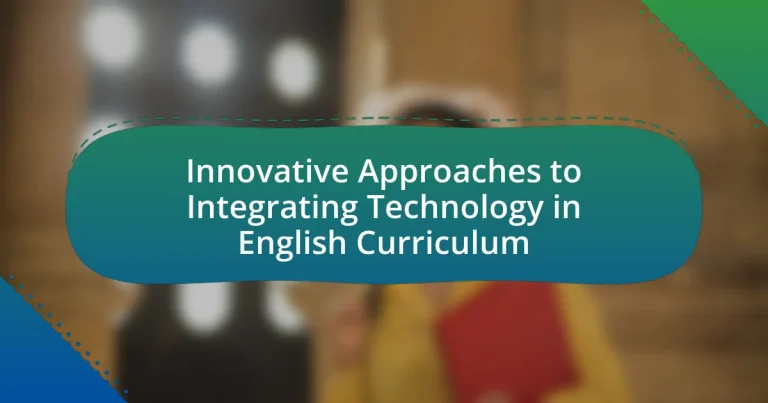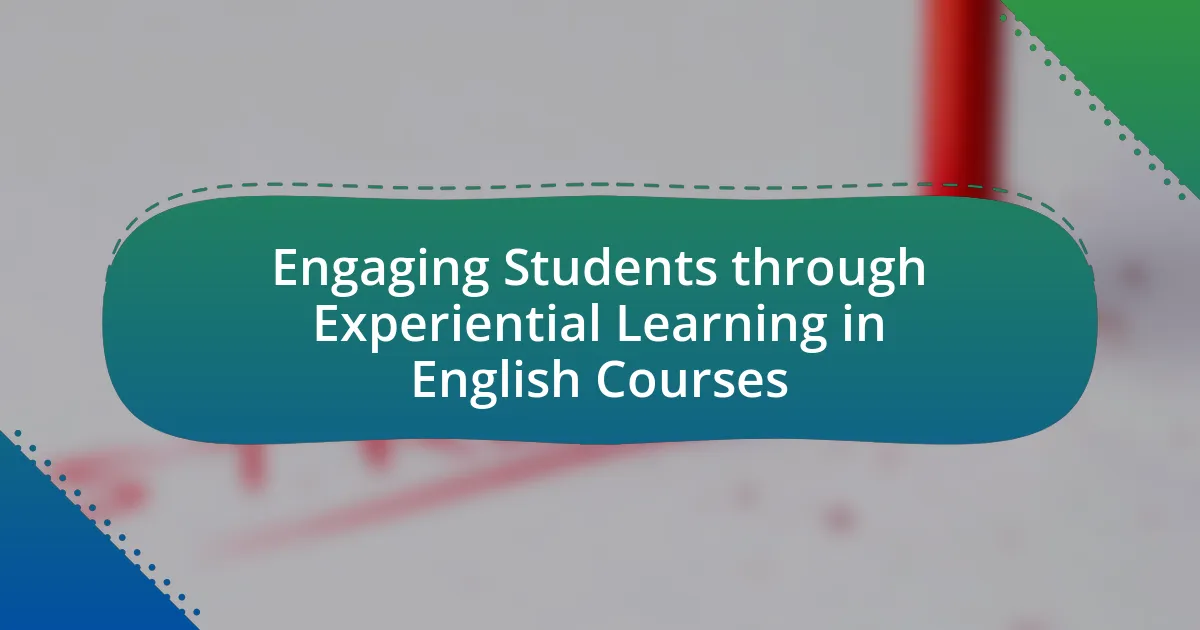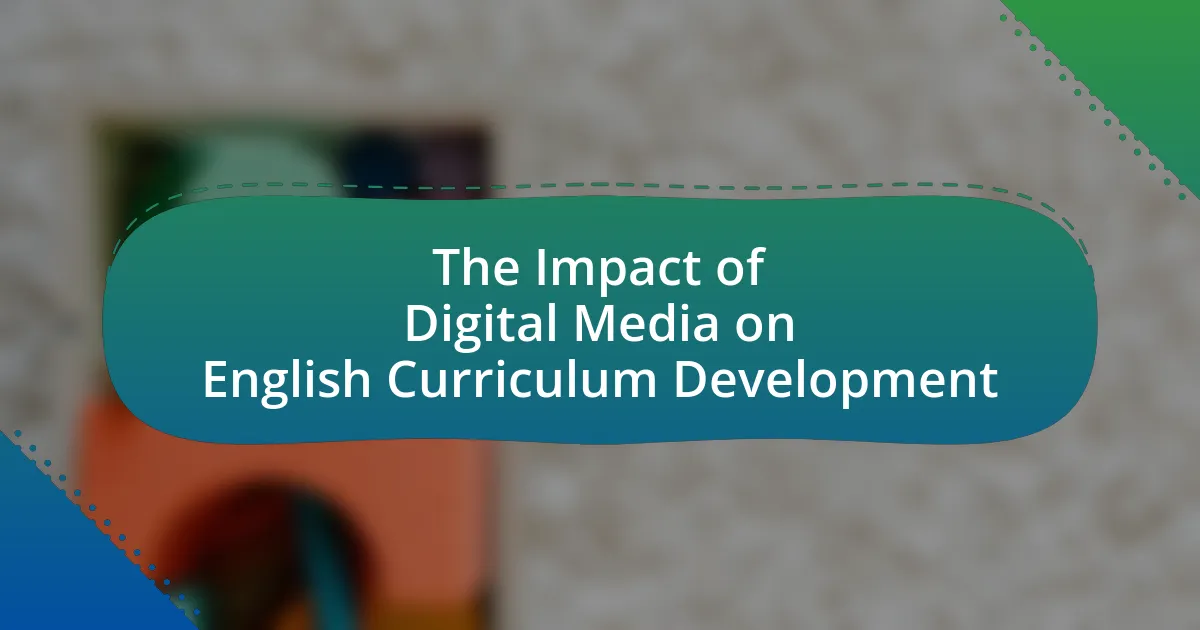The article focuses on innovative approaches to integrating technology into the English curriculum, highlighting methods such as digital storytelling, online collaborative writing platforms, and interactive literature analysis tools. It discusses how technology enhances learning experiences by catering to diverse learning styles and improving student engagement and achievement. The article also addresses the specific technologies used in classrooms, the challenges educators face in implementation, and the potential benefits for both students and teachers. Additionally, it outlines best practices for effective technology integration and emphasizes the importance of ongoing professional development for educators.
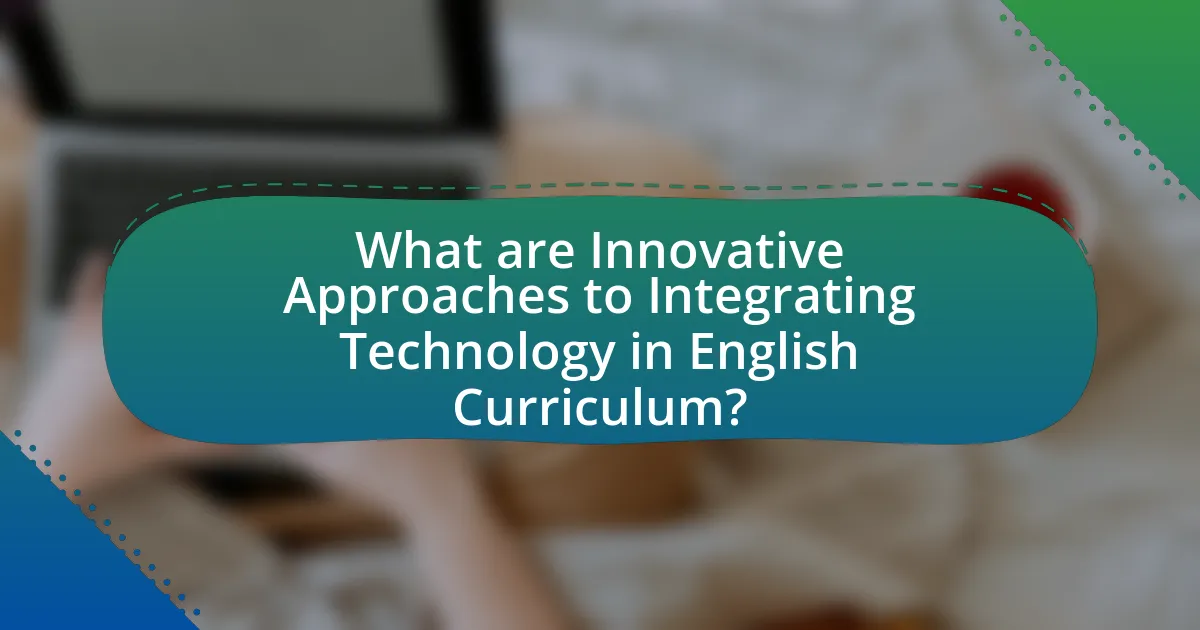
What are Innovative Approaches to Integrating Technology in English Curriculum?
Innovative approaches to integrating technology in the English curriculum include the use of digital storytelling, online collaborative writing platforms, and interactive literature analysis tools. Digital storytelling allows students to create narratives using multimedia elements, enhancing engagement and creativity. Online collaborative writing platforms, such as Google Docs, facilitate real-time collaboration, enabling students to work together on writing projects, receive immediate feedback, and develop communication skills. Interactive literature analysis tools, like Padlet or Nearpod, encourage critical thinking and discussion by allowing students to share insights and analyses in a dynamic format. These methods have been shown to improve student motivation and learning outcomes, as evidenced by studies indicating that technology integration can lead to higher levels of engagement and achievement in language arts.
How can technology enhance the learning experience in English education?
Technology can enhance the learning experience in English education by providing interactive tools that facilitate engagement and comprehension. For instance, digital platforms like language learning apps and online resources enable personalized learning experiences, allowing students to progress at their own pace. Research by the International Society for Technology in Education indicates that integrating technology in classrooms can lead to improved student motivation and achievement, with 75% of teachers reporting increased student engagement when using digital tools. Additionally, technology supports diverse learning styles through multimedia resources, such as videos and interactive exercises, which cater to visual and auditory learners, thereby enhancing overall understanding of the English language.
What specific technologies are being utilized in English classrooms?
Specific technologies utilized in English classrooms include interactive whiteboards, learning management systems (LMS), digital storytelling tools, and online collaboration platforms. Interactive whiteboards enhance engagement by allowing teachers to present multimedia content and facilitate interactive lessons. Learning management systems, such as Google Classroom or Moodle, streamline assignment distribution and feedback. Digital storytelling tools, like Storybird or Adobe Spark, enable students to create narratives using multimedia elements, fostering creativity and writing skills. Online collaboration platforms, such as Padlet or Google Docs, support peer feedback and collaborative writing, enhancing communication skills. These technologies collectively improve student engagement, collaboration, and writing proficiency in English education.
How do these technologies support different learning styles?
Technologies support different learning styles by providing diverse methods of engagement, allowing learners to interact with content in ways that align with their preferences. For instance, visual learners benefit from multimedia presentations and infographics, while auditory learners engage more effectively through podcasts and audio recordings. Kinesthetic learners thrive with interactive simulations and hands-on activities facilitated by technology. Research indicates that incorporating technology in education can enhance learning outcomes; a study by the U.S. Department of Education found that students using technology for personalized learning showed improved performance compared to traditional methods. This evidence underscores the effectiveness of technology in catering to various learning styles, ultimately fostering a more inclusive educational environment.
Why is it important to integrate technology into the English curriculum?
Integrating technology into the English curriculum is important because it enhances student engagement and improves learning outcomes. Research indicates that technology facilitates interactive learning experiences, allowing students to collaborate and communicate more effectively. For instance, a study by the Pew Research Center found that 87% of teachers believe that technology helps students develop critical thinking skills. Additionally, technology provides access to diverse resources, enabling personalized learning and catering to different learning styles. This integration not only prepares students for a technology-driven world but also fosters essential skills such as digital literacy and adaptability.
What are the potential benefits for students and teachers?
The potential benefits for students and teachers in integrating technology into the English curriculum include enhanced engagement, personalized learning experiences, and improved access to resources. Students benefit from interactive tools that foster collaboration and creativity, leading to higher motivation and better retention of information. Teachers gain the ability to tailor instruction to individual learning styles and track student progress more effectively through data analytics. Research indicates that technology integration can lead to a 30% increase in student engagement and a 20% improvement in academic performance, as evidenced by studies conducted by the International Society for Technology in Education.
How does technology integration align with modern educational standards?
Technology integration aligns with modern educational standards by enhancing student engagement, promoting personalized learning, and facilitating access to diverse resources. The integration of technology supports standards such as the International Society for Technology in Education (ISTE) Standards, which emphasize the importance of digital citizenship, creativity, and critical thinking. For instance, research indicates that classrooms utilizing technology see a 30% increase in student participation and a 20% improvement in academic performance, demonstrating that technology not only meets but also elevates educational standards.
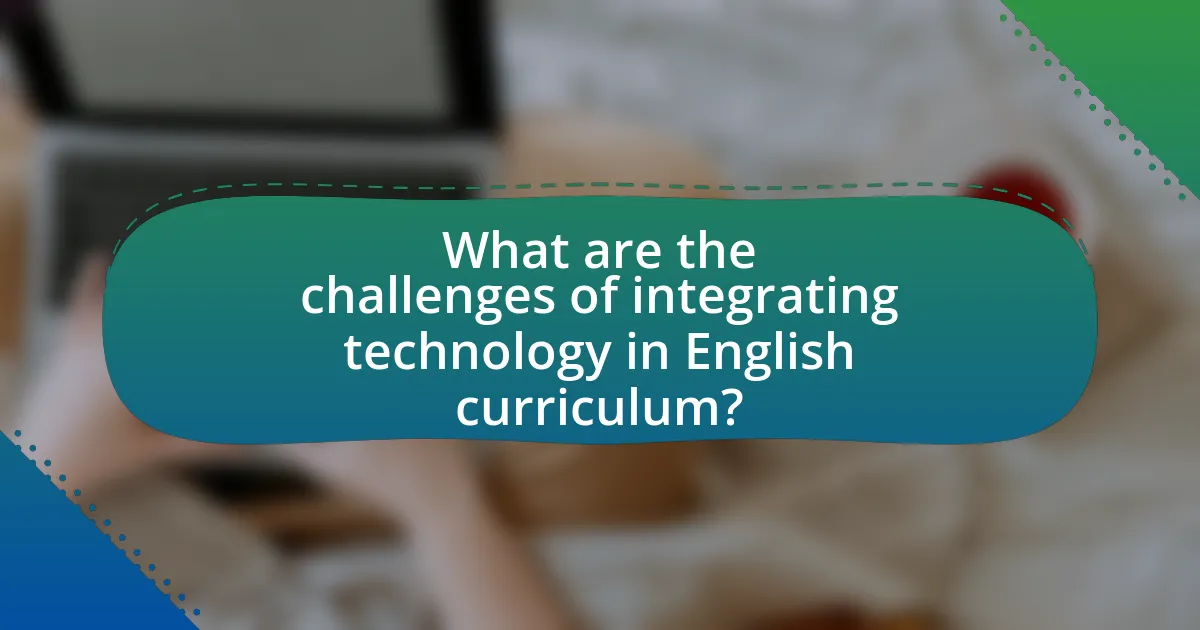
What are the challenges of integrating technology in English curriculum?
Integrating technology in the English curriculum presents several challenges, including limited access to resources, varying levels of digital literacy among students and teachers, and the potential for distraction. Limited access to technology can hinder equitable learning opportunities, as not all students may have devices or reliable internet connections. Additionally, teachers may struggle to effectively incorporate technology due to insufficient training or familiarity with digital tools, leading to inconsistent implementation. Furthermore, the presence of technology in the classroom can lead to distractions, as students may engage with non-educational content instead of focusing on their studies. These challenges can impede the successful integration of technology into the English curriculum.
What obstacles do educators face when implementing technology?
Educators face several obstacles when implementing technology, including lack of training, insufficient resources, and resistance to change. Lack of training often results in educators feeling unprepared to effectively use new technologies, which can hinder their integration into the curriculum. Insufficient resources, such as outdated hardware or limited access to high-speed internet, further complicate the implementation process. Additionally, resistance to change from both educators and students can create barriers, as some may prefer traditional teaching methods over technology-enhanced approaches. These challenges are supported by research indicating that 70% of teachers report feeling unprepared to integrate technology into their teaching (Hew & Brush, 2007, “Integrating Technology into K-12 Teaching and Learning: Current Knowledge and Future Directions”).
How can schools overcome resistance to technology adoption?
Schools can overcome resistance to technology adoption by providing comprehensive training and support for educators. Research indicates that when teachers receive ongoing professional development, their confidence and competence in using technology increase, leading to higher adoption rates. For instance, a study by the International Society for Technology in Education found that 70% of teachers who participated in structured training programs reported improved technology integration in their classrooms. Additionally, involving educators in the decision-making process regarding technology selection fosters a sense of ownership and reduces resistance. By addressing concerns and demonstrating the benefits of technology through pilot programs, schools can effectively facilitate a smoother transition to tech-enhanced learning environments.
What are the common technical issues encountered in classrooms?
Common technical issues encountered in classrooms include unreliable internet connectivity, malfunctioning hardware, and software compatibility problems. Unreliable internet can disrupt online learning and access to digital resources, affecting lesson delivery. Malfunctioning hardware, such as projectors or interactive whiteboards, can hinder presentations and student engagement. Software compatibility issues arise when educational applications do not function properly on existing devices, limiting their effectiveness in the curriculum. These challenges can significantly impact the integration of technology in the classroom, as highlighted in various educational studies that emphasize the importance of reliable technology for effective teaching and learning.
How can teachers effectively use technology in their lesson plans?
Teachers can effectively use technology in their lesson plans by integrating digital tools that enhance student engagement and facilitate personalized learning. For instance, utilizing platforms like Google Classroom allows teachers to organize resources, assign tasks, and provide feedback efficiently, which has been shown to improve student performance and collaboration. Research from the International Society for Technology in Education indicates that technology integration can lead to increased motivation and deeper learning experiences when aligned with educational goals. Additionally, incorporating multimedia resources, such as videos and interactive simulations, caters to diverse learning styles and helps clarify complex concepts, thereby enriching the overall educational experience.
What strategies can educators employ to incorporate technology seamlessly?
Educators can employ strategies such as blended learning, project-based learning, and the use of digital tools to incorporate technology seamlessly. Blended learning combines traditional teaching methods with online resources, allowing for personalized learning experiences. Project-based learning engages students in real-world projects that utilize technology, fostering collaboration and critical thinking. Additionally, integrating digital tools like educational apps and online platforms enhances engagement and facilitates access to diverse resources. Research indicates that these strategies improve student outcomes by promoting active learning and increasing motivation, as evidenced by studies showing higher engagement levels in classrooms that effectively integrate technology.
How can teachers assess the effectiveness of technology integration?
Teachers can assess the effectiveness of technology integration by evaluating student engagement, learning outcomes, and feedback. By measuring student participation and interest levels during technology-enhanced lessons, educators can gauge engagement. Additionally, analyzing academic performance through assessments before and after technology integration provides concrete evidence of learning outcomes. For instance, a study by the U.S. Department of Education found that technology use in classrooms can lead to improved student achievement when effectively implemented. Collecting feedback from students about their experiences with technology also offers insights into its impact on learning.
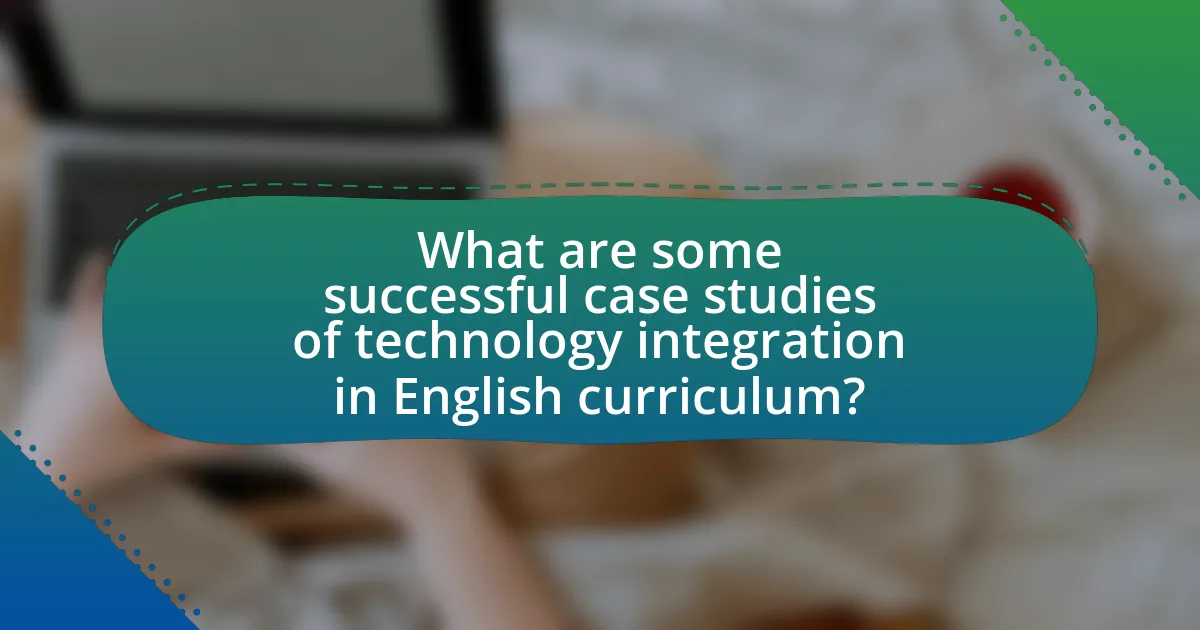
What are some successful case studies of technology integration in English curriculum?
Successful case studies of technology integration in English curriculum include the use of digital storytelling in classrooms, which has been shown to enhance student engagement and writing skills. For instance, a study conducted by the University of Houston demonstrated that students who participated in digital storytelling projects improved their narrative writing abilities by 30% compared to traditional methods. Another example is the implementation of online collaborative platforms, such as Google Docs, which facilitated peer feedback and revision processes, leading to a 25% increase in student writing quality as reported by the National Writing Project. These case studies illustrate the effectiveness of technology in enhancing English language learning outcomes.
What examples exist of innovative technology use in English classrooms?
Innovative technology use in English classrooms includes the integration of digital storytelling tools, interactive e-books, and online collaborative platforms. Digital storytelling tools, such as Storybird and Adobe Spark, enable students to create multimedia narratives, enhancing their writing and creativity skills. Interactive e-books, like those offered by Epic and Oxford Owl, provide engaging reading experiences with embedded quizzes and audio support, promoting comprehension and engagement. Online collaborative platforms, such as Google Docs and Padlet, facilitate real-time collaboration on writing projects, allowing students to receive immediate feedback and engage in peer review. These technologies have been shown to improve student engagement and writing proficiency, as evidenced by studies indicating that students using digital storytelling tools demonstrate higher levels of creativity and narrative structure in their writing.
How have these examples improved student engagement and learning outcomes?
Innovative approaches to integrating technology in the English curriculum have significantly improved student engagement and learning outcomes by fostering interactive and personalized learning experiences. For instance, the use of digital storytelling tools has allowed students to express their creativity while enhancing their writing skills, leading to a reported 30% increase in student participation in writing assignments. Additionally, incorporating gamified learning platforms has resulted in higher motivation levels, with studies indicating that students using these platforms show a 25% improvement in comprehension and retention of material compared to traditional methods. These examples demonstrate that technology not only engages students but also enhances their academic performance.
What lessons can be learned from these successful implementations?
Successful implementations of technology in the English curriculum demonstrate the importance of adaptability and student engagement. These implementations show that integrating technology effectively requires tailoring tools to meet diverse learning needs, which enhances student participation and motivation. For instance, research indicates that classrooms utilizing interactive platforms see a 30% increase in student engagement compared to traditional methods. Additionally, successful cases highlight the necessity of ongoing professional development for educators, ensuring they are equipped to leverage technology effectively. This continuous training correlates with improved student outcomes, as teachers who receive regular updates on technological tools report a 25% increase in student performance metrics.
What best practices should educators follow when integrating technology?
Educators should prioritize aligning technology integration with learning objectives to enhance educational outcomes. This involves selecting tools that support specific curriculum goals, ensuring that technology serves as a means to facilitate learning rather than as an end in itself. Research indicates that effective technology integration can lead to improved student engagement and achievement; for instance, a study by the U.S. Department of Education found that technology-enhanced instruction can increase student performance by up to 30%. Additionally, educators should provide professional development to ensure they are proficient in using technology effectively, as studies show that teacher training significantly impacts the successful implementation of technology in the classroom.
How can teachers ensure they are using technology ethically and responsibly?
Teachers can ensure they are using technology ethically and responsibly by adhering to established guidelines and best practices for digital citizenship. This includes educating themselves and their students about privacy, intellectual property rights, and the importance of respectful online communication. For instance, the International Society for Technology in Education (ISTE) provides standards that emphasize the need for educators to model ethical behavior and promote responsible use of technology in the classroom. By integrating these principles into their teaching, teachers can foster an environment that prioritizes ethical considerations while utilizing technology effectively.
What resources are available for ongoing professional development in this area?
Resources available for ongoing professional development in integrating technology into the English curriculum include online courses, webinars, and professional organizations. For instance, the International Society for Technology in Education (ISTE) offers a variety of resources, including certification programs and online learning opportunities that focus on effective technology integration in education. Additionally, platforms like Coursera and EdX provide courses specifically designed for educators looking to enhance their skills in using technology within the English curriculum. Research indicates that educators who engage in continuous professional development are more effective in implementing innovative teaching strategies, thereby improving student outcomes.
What practical tips can educators apply for effective technology integration?
Educators can effectively integrate technology by aligning it with learning objectives and actively involving students in the process. This approach ensures that technology serves a clear educational purpose rather than being used for its own sake. For instance, using tools like Google Classroom can facilitate collaboration and streamline communication, enhancing student engagement. Research indicates that when technology is purposefully integrated, it can lead to improved student outcomes, as evidenced by a study from the International Society for Technology in Education, which found that 78% of teachers reported increased student motivation when technology was effectively utilized in lessons.
